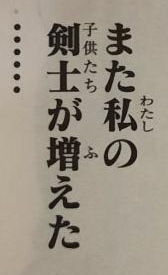Furigana
The practice of annotating phonetic readings on top of kanji words.
It is often (but not always) used to aid the person who is reading and might not be familiar with certain kanji or spellings.
Furigana is also often called ‘ruby’ text or characters.
Example:
- 魚
- 家
- 亜米利加
- Latin Text
As you can see, there’s no hard rules about what goes in furigana. For some Ateji words, you will often see katakana as furigana. Sometimes authors even like having fun and put kanji as furigana for other kanji:

Origins
When Kanji first arrived in Japan, it was used to render Chinese (usually religious) scriptures. In the timespan of half a millennia-ish (400AD -> 1000AD) kanji became not only a Chinese import, but also a representation of the local language with complex pronunciations and readings (see: Onyomi and Kunyomi).
As a practice common in all Chinese territories at the time, like the Korean peninsula or Vietnam, various glossings and annotations were added to these Chinese scriptures to make it easier to scholars and Buddhist monks to recite the text out loud in the local language/dialect.
In the same manner, these annotations were also used in Japan to distinguish between words written in kanji as Chinese, and words written in kanji for grammar or Japanese readings (as kana script had not yet been invented).
These annotations are called 訓点 and the practice of annotating classical Chinese texts (also called 漢文) is called 加点.
Modern Use
You’ll find furigana everywhere and especially for Japanese learners it can be a lifesaver. It makes it easier to read complex words and also makes it possible to look up 熟語 by their readings in a dictionary insead of having to rely on radical search or having to draw the kanji (see also: How do I look up the meaning of this kanji?).
Depending on the publisher and the author’s own preferences, books will sometimes follow certain established rules on where to apply furigana:
- On a lot of young reader’s manga like 少年 or 少女 genres, you will see furigana on every single kanji word;
- In some light novels or books, publishers will require all Ateji words to have their furigana reading clearly displayed;
- Words that use non-常用漢字 (kanji outside of those every adult is expected to know) will often have furigana;
- Sometimes it’s just totally random lol ¯\_(ツ)_/¯
Another very common practice of using furigana is that of adding inconsistent or unusual readings on top of certain kanji used as 義訓 for poetic or literary purposes. See: Gikun (義訓)#